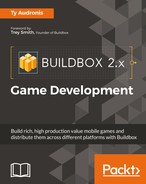WOW! We've come a long way, haven't we? All in one chapter as well. In this short time, we've learned how to set up our directory structure and prepare our environment to develop using naming conventions, and the Game Creator screen.
You've also learned more about the Game Mind Map, and used it to rename a world, and shortcut it to more easily test your game. We've also learned a great deal about the graphic formats for Buildbox, why they're used, and how to properly use them to make your game as resource-efficient as possible.
Backgrounds were interesting, and we got through all of the basics of instituting them with the principles of parallax. How did you enjoy seeing your background go by when testing the game? Pretty cool, right? But that's not all: we learned about image sequence animations, and how Buildbox uses them to make objects come to life.
We also got a chance to check out the basics of connections and parenting, and how they apply to a vehicle-based game. We also got to put our own graphics in the game and adjust the collision shapes so that they can work properly. We furthermore replaced all the graphics animations in our character, and even brought in an explosion for the destruction animation of our character.
We created two scenes with interesting and challenging obstacles to start our game, and we talked about the strategies of level design. We also got some tips and tricks to make obstacles more interesting and even give players choices by using collision shapes to make a cave (and a drivable top to the cave).
And finally, we learned how to set up our controls and how to test the game itself, and use that testing to adjust our obstacles to make them more usable. My, my, my... that was a lot to learn. This is a great time to take a break, and test your game some more to really get a feel for how to use the rover, and maybe even play around with the scenes we created to trick them out to your taste.
In the next chapter, Chapter 4, Advanced World Design — Ramblin' Rover, Part 2, we'll be moving on to more intermediate-level work within Buildbox. We'll create some physics-based obstacles to increase the challenge of our game, we'll again go over level-based versus endless games, and how to make your game level-based. We'll even create a secret level for the game! If you're unsure of anything we've covered so far, please go back and review, because the next chapter depends on everything you've learned here. You're well on your way!
